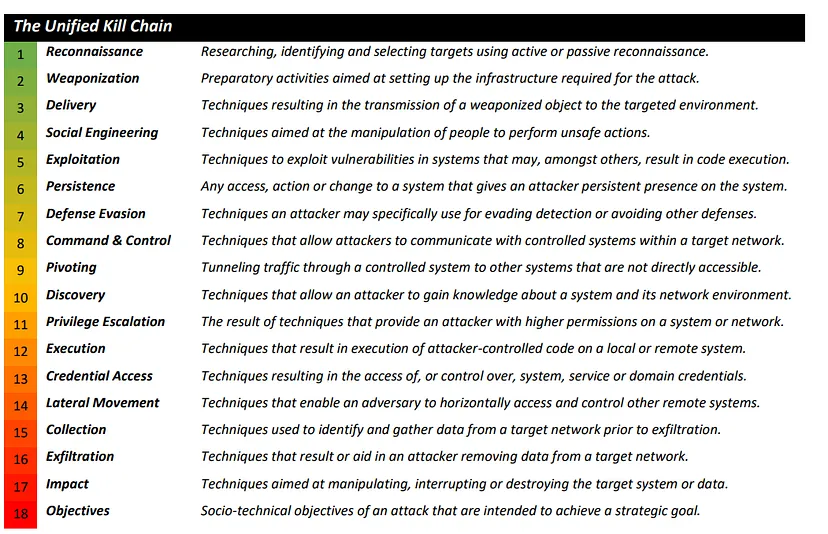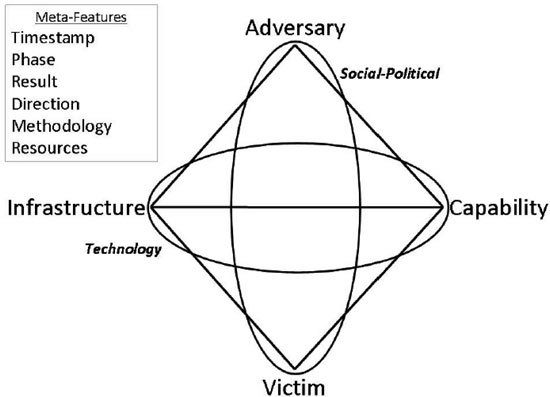Security Frameworks
Guidelines used for building plans to mitigate risks and threats
Purpose: Protecting PII, Protecting Financial data, Identify Security Weakness, Managing Risks, Aligning security with business goals
Components: Setting Goals, Setting Guidelines, Implementing Processes, Monitoring & Communicating Results
Lockheed Martin Cyber Kill Chain
Reconnaissance: Attacker determines what methods to use to complete/ perform the attack. Uses passive OSINT to gather information on target
Weaponization: Attacker couples payload code (enables access) along with exploit code (exploits vulnerability on system)
Delivery: The attacker identifies a vector by which to transmit the weaponized code to the target environment
Exploitation: The weaponized code is executed on the target system by this mechanism
Installation: This mechanism enables the weaponized code to run a remote access tool and achieve persistence on the target system
Command & Control (C2): The weaponized code establishes an outbound channel to a remote server that can then be used to control the remote access tool and possibly download additional tools to progress the attack
Actions on Objective: The attacker typically uses the access he has achieved to covertly collect information from the target systems and transfer it to a remote system (data exfiltration) or archive other goals and motives
Main focus of Framework: Malware Delivery and Network Security
Does not detect: Insider Attacks
Unified Kill Chain (UKC)
Unified Kill Chain: Raising Resilience Against Cyber Attacks

Phase 1: In - Attacker tried to establish a initial foothold - Make of the 1st 9 stages
Phase 2: Through - Attack seeks to gain additional privileges - Covers Stages 9 to 14
Phase 3: Out - Action of Objective of Attack - Covers Stages 15 to 18
Diamond Model of Intrusion Analysis
A framework for analyzing cybersecurity incidents and intrusions by exploring the relationship between four core features: adversary, capacity, infrastructure and victim
Adversary Operator: Hacker conducting the intrusion activity
Adversary Customer: Entity that stands to benefit from the intrusion activity
Victim Persona: People and organization being targeted
Victim Assets: The attack surface that is used
Type 1 Infrastructure: Infrastructure controlled by Adversary
Type 2 Infrastructure: Infrastructure controlled by a intermediary
Extended Diamond Model consists additionally 6 meta-features and 2 axis’s:
Meta-Features: Timestamp, Phase, Result, Direction, Methodology, Resources
Axis: Social-Political & Technology

MITRE ATT&CK Framework
A globally accessible knowledge base mentioned by MITRE for listing and explaining adversary tactics, techniques and procedures
Tactic: Step in an attackers methodology
Technique: How the tactic is orchestrated
Procedure: Implementations of a technique (and sub-techniques)
The pre-ATT&CK matrix contains the reconnaissance and weaponization phase
The ATT&CK Enterprise matrix contains the remaining stages of the Cyber Kill Chain
Recently, the pre-ATT&CK matrix was merged into the Enterprise matrix
Separate matrices are present for mobile and ICS (Industrial Control Systems)
NIST Risk Management Framework (RMF)
Prepare: Steps that are required to manage security before a incident occurs
Categorize: Used to develop risk management processes
Select: Choose, customize and capture documents that controls the protection
Implement: Implement security and privacy plans
Assess: Determine if controls are implemented correctly
Authorize: Being accountable for the security and privacy risks that might exist
Monitor: Be aware of how systems operate
NIST Cyber Security Framework (CSF)
Identify: Management of risks and its effects on people and assets
e.g. Monitoring organizations assets to detect security incidents
Protect: Strategy used to protect an organization (policies, procedures, training, tools)
Detect: Identifying potential security incidents and improving monitoring
Respond: Ensure proper procedures are used to contain, neutralize and analyze incident
Recover: Return affected systems to normal operations
NIST S.P. 800-53: NIST CSF designed to be used by the federal government
Core: The desired security outcome of a security plan (the 5 functions above)
Tiers: A way of measuring the sophistication of an organizations cybersecurity program
Profile: Templates that are tailored to address the specific risks of an organization
OWASP Security Principles
Minimize attack surface area: Disable unrequired features, complex passwords, etc.
Principle of least privilege: Limits the damage done when breach occurs
Defense in depth: Should use multiple different security controls (MFA, Firewalls, ACL, IDS) Separation of duties: Critical actions should rely on multiple people
Keep security simple: Complex security systems can become unmanageable
Fix security issues correctly: Weak Wi-Fi passwords, etc.
OWASP Developer Guide | Principles of Security | OWASP Foundation